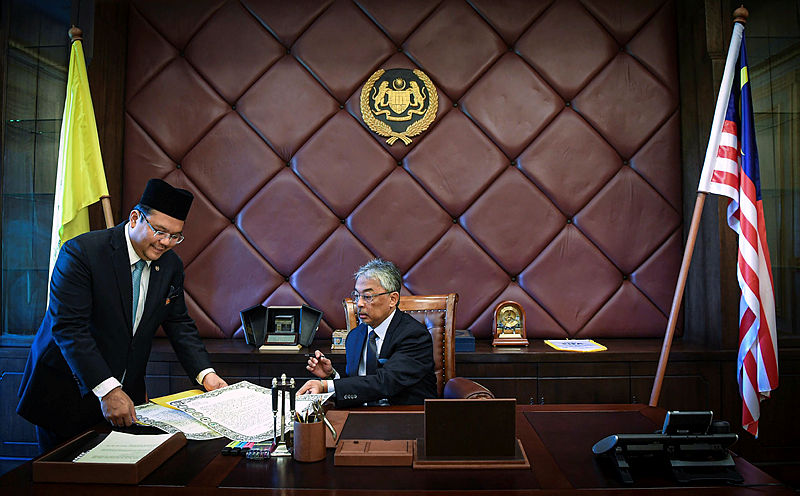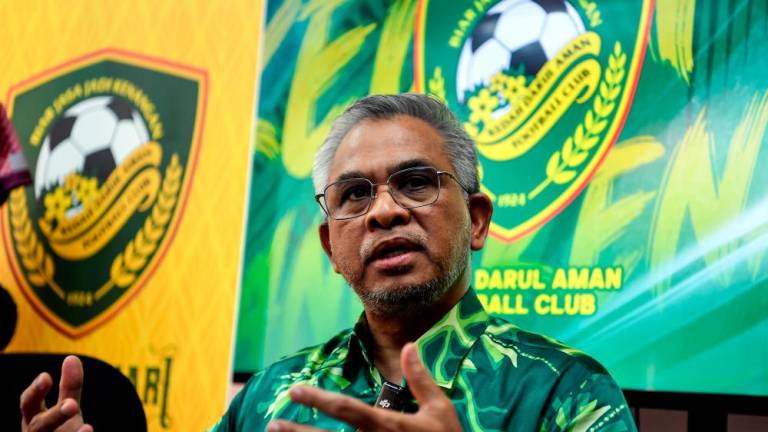ANCIENT Malay texts such as ‘Tuhfat Al-Nafis’ and ‘Sulalatus Salatin’ have it that when a message has to be delivered to a ruler, it has to be done decorously and in a manner befitting royalty.
And, the messenger bearing the letter is no ordinary mortal but one who has earned the trust of the ruler.
In an era where messages are conveyed instantly via WhatsApp or email, the traditional practice of delivering special epistles by hand is still closely observed in royal circles in this country.
The same goes for the instrument of invitation requesting the Malay rulers and Yang di-Pertua Negri to grace the installation ceremony of the 16th Yang di-Pertuan Agong Al-Sultan Abdullah Ri’ayatuddin Al-Mustafa Billah Shah on July 30.
This tradition dates back to the time when Tuanku Abdul Rahman Ibni Al-Marhum Tuanku Muhammad (Negri Sembilan) was installed as the first Yang di-Pertuan Agong and has been maintained since then.
Jawi script
Grand Chamberlain (Datuk Paduka Maharaja Lela) of Istana Negara Azuan Effendy Zairakithnaini said similar to how it was done in the olden days, the message in the instrument of invitation for the Yang di-Pertuan Agong’s installation ceremony is in Bahasa Melayu and carefully handwritten in beautiful calligraphic Jawi script.
He said the wording for the invitation used the traditional language used by royalty, with special emphasis given to the appropriate honorifics for addressing the sultans who were older or younger than the King.
He also said that the royal invitation was designed by Raja Permaisuri Agong Tunku Azizah Aminah Maimunah Iskandariah herself.
“The Queen also requested that the state emblems be printed on the invitation as a symbol of unity of the Malay rulers,“ he told Bernama.
Gold-coloured tray
The delegation entrusted with the responsibility of delivering the royal invitations comprised Azuan Effendy himself as a representative of Istana Negara, and representatives from the Prime Minister’s Department and the Office of the Keeper of the Royal Seal.
The team is headed by Minister in the Prime Minister’s Department Datuk Seri Mujahid Yusof Rawa, who chairs the special committee on the Installation Ceremony of the 16th Yang di-Pertuan Agong.
“The royal invitations were presented to the rulers in accordance with (the related) customs and traditions,“ said Azuan Effendy.
Each invitation is rolled up and inserted into a gold-coloured cylindrical-shaped case that is placed on a tray which is also gold-coloured.
In some states, he added, the sultans would grant permission for the contents of the invitation to be read out before them by a member of the delegation.
“This is in keeping with past traditions when the messenger would read out the (contents of) instrument,“ he said.
Careful attention
Calligrapher Abdul Baki Abu Bakar, 45, told Bernama that writing in calligraphy on the royal invitation required a great deal of care and caution as well.
Abdul Baki, who hails from Sik, Kedah, said the writing itself was a slow process as he had to take pains to see that the ink did not spill on the paper, besides ensuring that he has adequate quantity of ink.
There is no room for error given that the paper being used is of high quality and sports the desired prints, with the space for the calligraphy text already fixed.
The paper’s features can also sometimes pose a challenge for the calligrapher as certain types of paper are more suitable for printing than for calligraphy purposes.
Abdul Baki, whose first calligraphy assignment for Istana Negara was in 2002 for the installation ceremony of the 12th Yang di-Pertuan Agong Tuanku Syed Sirajuddin Ibni Al-Marhum Tuanku Syed Putra Jamalullail of Perlis, said there have been times he had to compromise when the paper selected by the palace turned out to be “not that suitable” for calligraphy writing.
He also noted that the length of the text for the invitation would depend on the rank and titles of each sultan.
“This is why it is important to prepare an initial draft of the text because it is during this stage that the details of the text are finalised,“ he said.
According to Abdul Baki, the types of calligraphy used for royal invitations are Nusukh and Tuluth.
Besides invitations, he also does calligraphy for the instrument of the oath, instrument of appointment and text of the speech of the Yang di-Pertuan Agong.
Permaisuri’s choice
Another calligrapher who is involved with the royal invitation for the installation ceremony of the 16th Yang di-Pertuan Agong is Jainal Sakiban, 72, who is also known as Ustaz Jainal and is from Batu Pahat, Johor.
In fact, the Raja Permaisuri Agong herself had requested for the services of Ustaz Jainal, who used to be her religious teacher. He had also served the Sultan of Johor, Sultan Ibrahim Sultan Iskandar when he was the Crown Prince during the early 1980s.
Ustaz Jainal was also the man behind the calligraphy for the invitation to the marriage of Yang di-Pertuan Agong Al-Sultan Abdullah Ri’ayatuddin to the Raja Permaisuri Agong, as well as their marriage certificate.
He has also done calligraphy for religious books and logos, among others.
Ustaz Jainal said the challenge he faced when doing calligraphy was ensuring that the pen’s nib was appropriate for the length of the text and the space allocated for it.
“It can be time-consuming looking for the right nib and doing the draft to check if the space allocated for the text is sufficient or not,“ he said, adding that mistakes often occur with regard to the titles used and that even if a single word is left out, the whole invitation has to be redone.
Invitations for foreign guests
Azuan Effendy said besides the Sultan of Brunei Sultan Hassanal Bolkiah, the Crown Prince of Abu Dhabi and Deputy Supreme Commander of the United Arab Emirates Armed Forces Sheikh Mohammed bin Zayed Al Nahyan, and Prince Ali Al-Hussein from Jordan have also been invited to attend the King’s installation ceremony.
“The invitations for the two princes are written in the Jawi script and Bahasa Melayu,“ he said, adding that the translation of the text into English and Arabic was coordinated by the Foreign Ministry.
“The important thing, for me, is to show our foreign guests how we present the royal invitation to the sultans, that is, in a way that befits royalty and is artistic as well as we use our heritage script, Jawi (for the text).” — Bernama













